The Top 10 Exciting Classroom Review Games for Active Learning

Classroom review games are one of the shiniest tools in an educator’s toolbelt. They’re a great way to ensure that what you taught has been understood while allowing students (and teachers) to have a little fun!
Here are 10 exciting review games to bring to your classroom that will keep your students engaged while you effortlessly track their progress. Check out the wide range of different mini games and the extensive list of demos and templates available to download. With these classroom review games, you’ll always have the right option for any review class.
Quizzes
Quizzes are perhaps the simplest and yet most variable of review games. They offer a wide range of opportunities for customization, different visuals, and content. They can be played in teams or by individual students.

How to play:
Set up: There are an infinite number of ways to make a quiz, but at its simplest, a quiz is just a series of questions. It’s like a test, but more fun. Remember to include lots of visuals and even special rounds to make the review questions more engaging.

Making a memorable and exciting quiz in iSpring Suite is straightforward. You can select from 14 question types, including hotspot and drag-and-drop quizzes, and make use of the huge wealth of resources in Content Library to enhance the student experience in your classroom review.
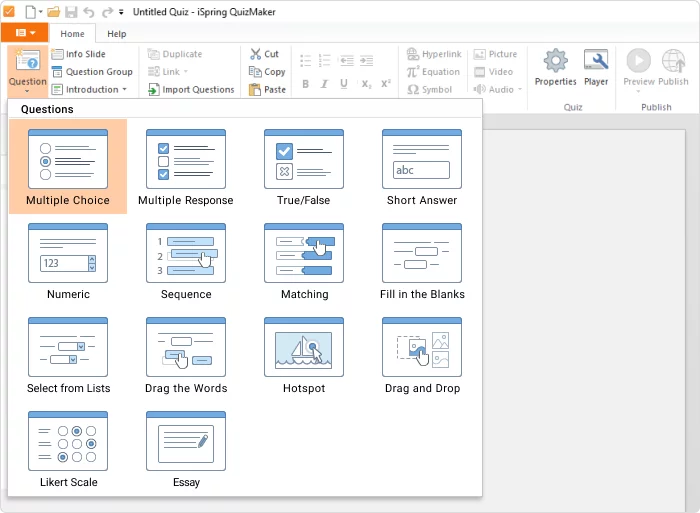
Play: Depending on how you designed your quiz, you may need to divide the class into teams or hand out answer sheets. To play the game, simply display one question or group of questions at a time and have the class answer in their teams or individually. Continue until you complete all the rounds.
Scoring a quiz is simple, but make sure to think about each quiz category and the point value for each question. You want your learners to feel as though the team with the most correct answers wins.
At the end of the quiz, collect each answer sheet and, if you like, you can award bonus points for the best team name!
Summary: Whether at the end of the lesson or for an entire class period, be sure to employ this fantastic teaching tool, as it’s so simple and versatile.
Role-Play Games
Boost student engagement by putting your learners into the actual situations that they’re learning to deal with. Whether simulating a conversation with a client, reimagining a historic event, or working together to overcome a crisis situation, your class will love this review game.

Make realistic and engaging role-play games with the iSpring Suite authoring toolkit.
Digital role-plays can be time-consuming to make, but are definitely worth the effort. A realistic and detailed role-play game will work wonders in helping students form lasting memories in your class. Making role-play games with branching can be a breeze with the help of iSpring Suite.
You can create beautiful lessons and learning resources with ease and let your educational creativity really flow. With this tool, teachers can build interactive role-plays with realistic and hand-drawn characters and backgrounds. iSpring Suite is the perfect tool for all your classroom review game needs, and it includes a 14-day free trial.
How to play:
Set up: Creating a role-play game can take 5 minutes or forever, depending on how much structure and support (or scaffolding) you want to provide your learners with, and also how creative you’re feeling. There is an infinite number of ways to create role-plays, so check out this guide on role-plays for the training industry.
Play: Have the class work together or divide the students into groups and have them work through the role-play. You can monitor progress and offer support if and when it’s needed. If your learners are feeling competitive, you can have them race to complete the game, and the first team to finish wins points.
Summary: Role-plays are incredibly fun and engaging, but require a little more preparation and creativity. Still, they are your chance to wow all the other teachers with your intricate role-play games.
Jeopardy
This is possibly the most popular classroom review game, and for good reason. Jeopardy is a quiz game but is formatted in a way to make it instantly addictive. Students can gamble on selecting the more difficult questions in order to score the highest points. All in all, it’s a simple yet fun game for the entire class.
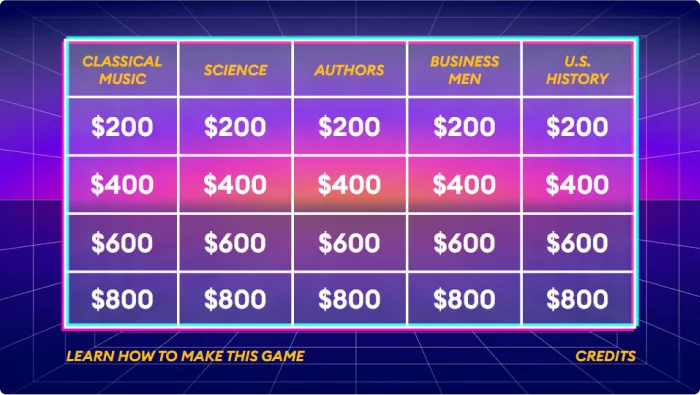
To make a Jeopardy game, lay out your board with a question behind each box.
How to play:
Set up: To prepare for a game of Jeopardy, all you need to do is select 5 categories from the topic you’re teaching and write 5 questions for each category, with each question harder to answer than the last.
Did you know that Jeopardy games can be made in PowerPoint? Check out this guide on how to make a Jeopardy game in PowerPoint now.
Play: To play the game, display the categories to the class and how many points each question is worth. With students in teams or as an entire class, call on an individual to select a question. Reveal the question and set a time within which an answer must be given. A correct answer wins the predetermined points. Keep going until all questions have been answered correctly. The team that scores the most points wins.
Summary: A Jeopardy game is both a television and a classroom hit. Bring excitement and entertainment into your lesson with this incredible review game.
Who Wants to Be a Millionaire?
This popular game show is so simple that it hurts. Students will love the challenge and satisfaction of answering increasingly trickier questions about the subject you have taught them. The incremental difficulty also provides an opportunity to engage learners of differing abilities, which is ideal for thorough test preparation.
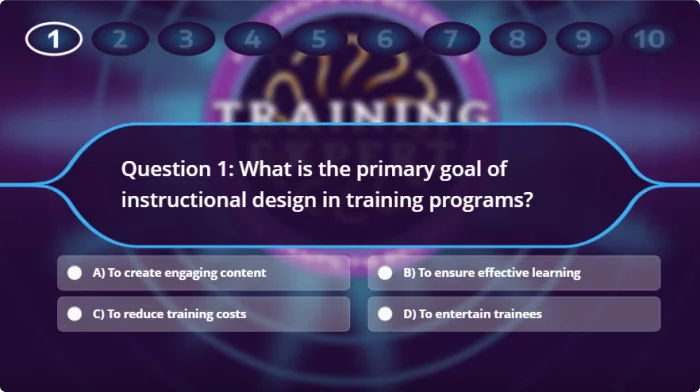
The sleek design of this game is perfect for your classroom.
How to play:
Set up: To prepare for this classroom review game, all you need is a series of questions that get increasingly harder and a timer. Make sure that your questions are multiple-choice and have four answers to choose from.
Play: Either nominate or ask your students to nominate one person to go first. The player then needs to answer each review question in order and within the time allowed. Even one incorrect answer means elimination.
As in the TV game show, you can give your students some lifelines:
50/50: You remove two of the incorrect answers from the board.
Phone a friend: Allow the player to choose one student to ask for advice.
Ask the audience: The rest of the class can vote for the answer they think is correct. They can vote on a whiteboard or a sticky note.
Summary: This is an iconic game show made into an exciting classroom review game. Keep the entire class engaged with suspense and drama as their champion tests their knowledge.
Family Feud
This classic game is an awesome way to engage students and make learning fun. High school students always seem to love the show and the game. What’s more, the format makes it super easy to work with in terms of review. It’s easy to see why it’s a classroom favorite.
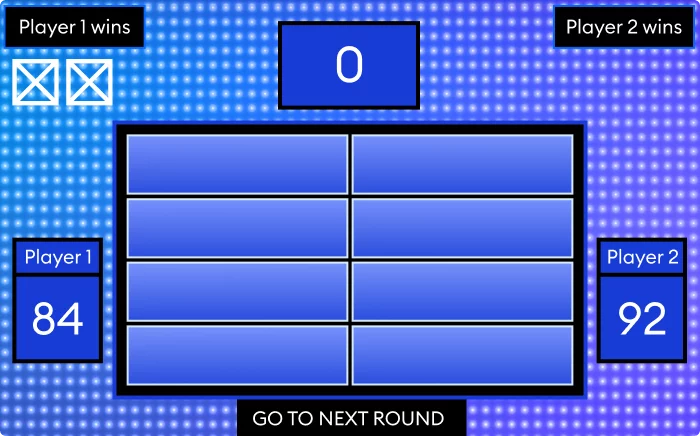
This classic TV show is a hit among students.
How to play:
Set up: All you need for this one is a handful of questions that have multiple possible answers. Each answer is worth a certain number of points. It’s super easy to make a Family Feud gameboard in PowerPoint.
Play: First, divide the class into two teams. Then, each team chooses one person to go first in each round. The chosen players will be asked the first question, and the first person to ‘buzz in’ will need to answer.
If the answer is correct, their team can attempt to provide all the answers on the board – without giving more than three wrong answers. If that happens, the other team takes over.
After all the answers are revealed, start the next round. The game ends when the questions run out and the team with the most points wins. If two teams have the same amount of points, go to sudden death!
Summary: Two teams play, but only one team can win. Students love this hectic game as they eagerly wait to take over from the opposing team’s turn to swoop in and score points.
Pictionary
Pictionary is a fantastic game to play with people of all ages. It’s a simple game in which players are given a word or phrase and have to make their team guess the term by drawing. As group activities go, it is one of the simplest and most enjoyable.

How to play:
Set up: All you need is a place for students to draw and a list of keywords or terms. The first can be achieved with a large piece of paper, a whiteboard, or a digital space. For the second, you’ll need a hat filled with strips of paper or a random word selector.
Play: You can play this game all together or in teams with numbers of your choosing. Students take turns selecting a keyword or phrase and then have a predetermined amount of time to draw. The rest of the team must try to guess the word or phrase from the drawing.
You use an approach in which teams elect a running order in their teams, or if playing as a whole class, the student who answers correctly can take the next turn. If playing in teams, then each team takes turns and will earn points for correct answers.
Summary: Regardless of whether students are skilled at drawing or not, this game will keep everyone involved as they try to guess the word. It’s great for increasing their vocabulary!
Charades
Charades is just like Pictionary, but instead of drawing, players must act out the keyword or key phrase. For this game, one student will be selected or nominated at a time to act out the word or phrase to the other students for this quick review game.
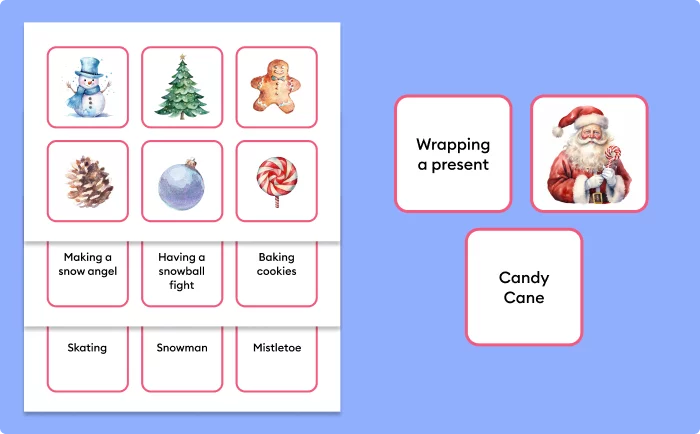
You can make a super simple charades prompt card for your class.
How to play:
Set up: As with Pictionary, you’ll need a list of terms, but this time, instead of somewhere to draw, the student will need somewhere to act. Again, this can be conducted in a classroom or an online space.
Play: The game can be played as a group or in teams. Just make sure to determine a points system and that you have as many active participants as possible. You can call on a disengaged student to be the next person to act if you wish.
Summary: Once again, creativity is key! Students will laugh themselves silly as they try to guess what term has been transformed into a dramatic performance.
Taboo
Another excellently simple game, Taboo is great for all kinds of classroom review sessions. In this review game, students endeavor to describe a word or phrase from the topic, but certain words are banned, or made ‘taboo.’
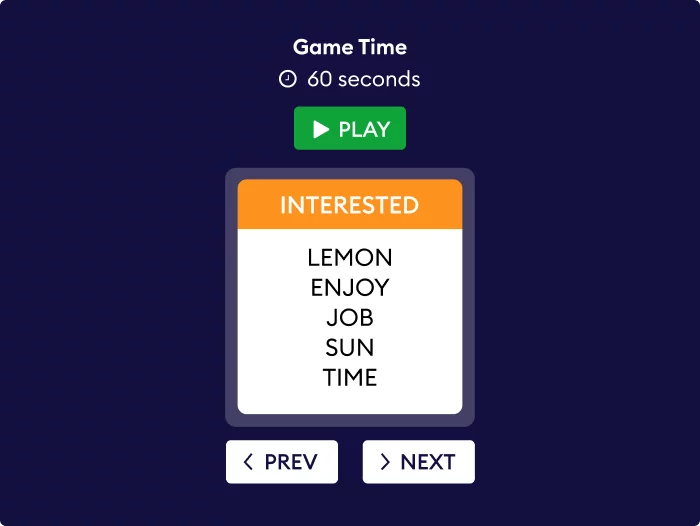
You can use a mobile app or display the review term on the screen to one student at a time.
How to play:
Set up: Like many games, taboo can be played all together, in teams, or even in pairs. To prepare, you just need to create cards or post-it notes with a review term on them and a list of closely associated ‘taboo words.’
Play: Either as a class or in their teams, students take turns, one at a time, to pick up a card or post-it note and give the other students clues so that they can guess the correct answer. Remember, no points are scored if a student uses the taboo words on the card!
Summary: Whether it’s a new vocabulary word or some complicated terminology, students will wrestle with their words to leave clues for others to guess the correct answer.
Hot Seat
Hot Seat is one of the most straightforward review games there is. The game is played as a group but can also be played in teams. Students compete to score the lowest number of points by guessing the review word or phrase while asking the fewest questions.
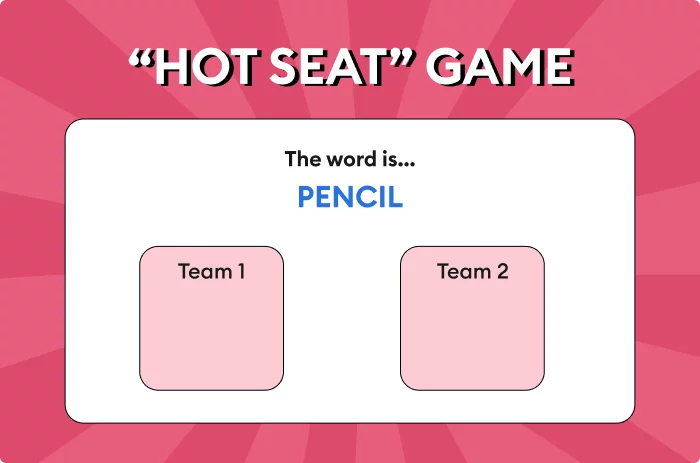
You can design a nice graphic to enhance the hot seat experience.
How to play:
Set up: This game requires very little setup. All you need is a seat at the front of the class so the student sitting in it can’t see the board.
Play: Students take turns to sit in the hot seat. Once seated, you can write or display a word or phrase on the board. The student in the hot seat now needs to guess the word that the rest of the class can see.
The learner in the hot seat can ask questions to determine what the term is. However, the other students can only answer questions with the words “yes” or “no.” Once the player in the hot seat has enough clues, they can guess the term and gain one point for every question they asked. The student with the fewest points wins!
Summary: Hot Seat is one of the simplest of all classroom review games. Get the entire room involved as students try to guess the word behind their back; and remember, the player with the fewest points at the end wins!
Word Association Game
A word association game works with almost any subject but is especially good for reviewing new vocabulary. Deceptively simple, this is one of the best classroom review games to help students learn a lot of new words or phrases and categorize them through association.

Be sure to keep the pace fast in this rapid-fire game!
How to play:
Set up: This game requires almost no setup; you simply need to designate an order for your students to answer in. Alternatively, you can find an item to throw around the room to randomize the order. Something like a beach ball does the trick.
Play: One student begins the game by saying a word or key term from the subject; the next student then has to quickly say a related or ‘associated term.’ If using the beach ball method, the student throws the ball to determine who goes next.
You can play elimination, wherein an incorrect answer or hesitating too long leads to a student being removed, in which case the last person left is the winner.
Summary: Word association games are simple, fun, and educational! What more could you ask for from a classroom activity?
FAQ
Let’s take a look at the most frequently asked questions about class review games.
What is the role of classroom review games?
Classroom review games play an important role in the classroom – whether physical or virtual. All review activities have two main functions. The first is to give your learners an opportunity to actually think about the information they have just been taught and to fill any gaps they may have. The second is for the teacher to assess and track the learning process and results of the class. Achieving both of these functions, while also allowing everyone to have some fun, is what makes classroom review games so useful.
What are practical tips for integrating games into lesson plans?
While a game is every high school student’s dream activity, there are some ways to prevent it from becoming a teacher’s nightmare. First, plan out your game and ideally run through the process yourself, start to finish, and understand the timing of your game so it doesn’t run too long or finish too early. Make sure to have all the necessary materials for your game for it to proceed smoothly. Lastly, remember to manage the behavior of the students: while some students can become a little overexcited about the prospect of a classroom game, gamification of content is actually a great carrot-and-stick tool for keeping the class on task throughout the process.
How Can You Measure the Success of Conducting Review Games in the Classroom?
Measuring the success of an activity like a game is not always easy, but here are some things to consider. First, did you and your students have fun? If yes, then your activity was successful. It can be easy to forget that learning should always be fun when possible. To measure the success of review games as an educational tool, successive reviewing is essential. Keeping track of students’ scores in review games and repeating the trickiest of the questions from the review activities is an important part of the process.
How do you make an interactive review game?
Some of the most asked-for teaching tips are related to creating materials for classroom activities. When it comes to making an interactive game, it’s really important to get things right to avoid a disaster in the classroom or end up sinking an enormous amount of time into lesson preparation unnecessarily.
With online tools like iSpring Suite, not only can you quickly and efficiently create exciting classroom review games, but you can also browse the collection of demos and templates. Why not try it out for free with the iSpring Suite 14-day free trial?



